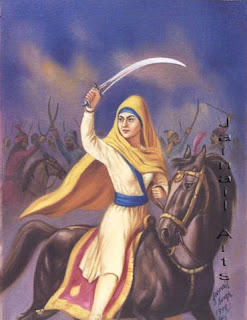
In her childhood, Mai Bhag Kaur was called Bhag Bhari, which means “fortunate”. On being baptized, she was named Bhag Kaur. In the Sikh history, she is known as Mai Bhago. She was born in a well known village, Jhabal, near
As a young girl she had heard about the martyrdom of Guru Arjan Dev, the wars of Guru Hargobind, injustice done to the Sikhs and their harassment by the Mughal army These left a deep impression on her tender mind. Sad news of the martyrdom of Guru Tegh Bahadur and his companions —Bhai Dayala, Bhai Mati Das, and Bhai Sati Das – touched her heart. She made up her mind to stop such injustice and violence against the Sikhs. She had inherited from her family ideals of bravery and courage. Faith, truth, and fearlessness were her ornaments. She had a well built body and looked like a soldier.
She, along with her family, visited Guru Tegh Bahadur twice. She also visited Anandpur with her father in 1699 when Guru Gobind Singh created the Khalsa and was baptized along with other members of her family. She wanted to stay there to learn the martial arts and become a saint soldier, but her father brought her back because she was a woman and women did not take part in the Sikh army in those days. However, she longed to join the Sikh army and started learning the art of warfare and horse riding from her father. She made a top knot of her head hair and covered it with a small turban. She had a spear in one hand, sword in the other, a shield on her shoulders and other small arms in her belt. She had fiery eyes on her bright face. In the beginning she aimed at small bushes outside the village with her small spear. Then she started piercing trees with her spear and learnt horse riding. Soon she became a staunch saint soldier.
She was married to Bhai Nidhan Singh of village Patti near
She, along with her husband, went from village to village and told the people the reality of deserters to them. Ladies of the deserters did not talk to them when they came back, cursed and taunted them. These ladies dressed themselves as soldiers and wanted to proceed with Mai Bhago. She said to the deserters, “Guru Ji has sacrificed his family and comforts for our freedom. We must stand up and protect our rights and faith. We should not hide ourselves like cowards. Everybody has to die. Why not die like a brave person? If you don’t join me, I shall take a party of women and die for the Guru.” She exhorted the ladies not to entertain the deserters and not to allow them to enter their houses. Her sharp and frank words pricked the conscience of the deserters and awakened their souls. She challenged their vanity and made them regret. She displayed manly spirit and courage.
They, along with their leader, Mahan Singh, marched to help the Guru and seek his forgiveness. They got armed and they took the oath to die fighting and not to retreat from the battlefield. They meant to make amends for the apostasy.
On their way, they came to know that the Guru was camping at the
A battle with the Mughal forces took place and Mai Bhag Kaur fought in the front lines. The mercenary soldiers could not face the devoted Sikhs. The Guru from the mound near the lake supported the Sikhs with showers of arrows. The army generals took to their heels and retreated to save their lives. They even left their wounded and dead soldiers back. It happened in 1705.
|
After the battle, the Guru came down from the mound and found that every member of Bhag Kaur’s party was either dead or wounded. He took care of them. Mai Bhag Kaur was lying badly injured. She was treated and soon she recovered fully. Bhai Mahan Singh was dying when Guru Ji reached him. Guru Ji put some water in Bhai Mahan Singh’s mouth and said to him, “I am proud of you all. What is your last wish?” Mahan Singh requested the Guru to forgive all the deserters and restore the snapped relationship so that they might die in peace and obtain salvation. The Guru agreed before Mahan Singh could breathe his last. The city of
The Guru praised the bravery of Mai Bhago. She told the Guru how the forty deserters had fought bravely and laid down their lives. The Guru asked her to go back to her village as her husband and brother had also died in that battle. She expressed her desire to become an active saint-soldier and stay in the service of the Guru. Her wish was granted and she stayed with the Guru as a member of his bodyguards. She accompanied the Guru to Damdama Sahib,
-By Sawan Singh in his book 'Noble and Brave Sikh Women'

Comments